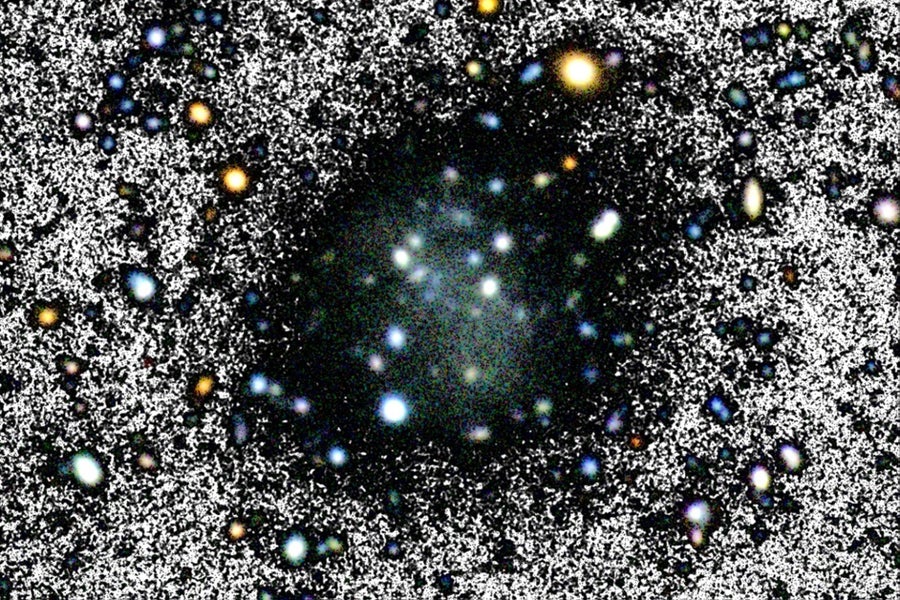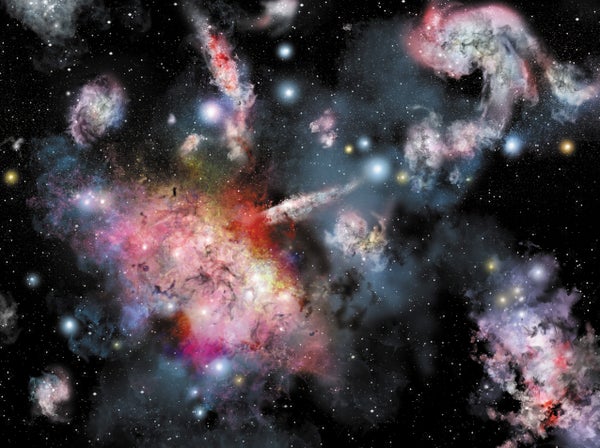In the summer of 2015 Ignacio Trujillo was sifting through deep-sky images when a slice of the constellation Cetus (“whale”) caught his attention. Sourced from a telescope in the universe-mapping Sloan Digital Sky Survey, the snapshot had captured an almost indiscernible “something” that was so obscured by noisy pixels that it could have been a banal artifact or an unremarkable fragment of a passing comet’s tail. But Trujillo, an astronomer at the Institute of Astrophysics of the Canary Islands (IAC) in Spain, had a scintilla of hope that he’d stumbled on something with more cosmic significance. When sharper images from better telescopes arrived nearly four years later, sure enough, a bluish fleck swam into view: a massive, ghostly blob of stars and gas that was so dim it had escaped the notice of other vigilant astronomers. The supremely puffy galaxy, estimated to be about 300 million light-years from Earth, is “much extended and larger than what it should be,” Trujillo says. “We’ve not seen anything like that.”
In early 2023—close to a decade after the galaxy’s first sighting—Trujillo and his colleagues contemplated many names for the find, looking for one that would commend its extraordinarily diffuse appearance.
The Spanish astronomer also showed the images to his daughter, who was then five years old. “Amelia, what do you think this is?” he asked. “Daddy, this is a nube, no?” she replied.
On supporting science journalism
If you're enjoying this article, consider supporting our award-winning journalism by subscribing. By purchasing a subscription you are helping to ensure the future of impactful stories about the discoveries and ideas shaping our world today.
Nube (pronounced “nooh-bey”) is Spanish for “cloud.” The name was “exactly what we were conceiving,” Trujillo says. He and his colleagues describe the newfound galaxy in a paper published this year in the journal Astronomy & Astrophysics. Follow-up observations, Trujillo says, could soon formally crown Nube as the biggest so-called ultradiffuse galaxy, or UDG—a category of galaxies defined by their very sparse stars and extreme associated faintness. Although neither Nube’s colossal size nor its scattered stellar population alone would merit much attention from astronomers, together they reveal a galaxy with a shockingly low and intriguingly uniform distribution of stars. Nube is, for instance, shaped “more like a pancake” than the bulging disk of our galaxy, the Milky Way, says study lead Mireia Montes of IAC. Yet the galaxy is “so faint you can barely see it.”
The galaxy and halo alike may be near-pristine relics that have scarcely changed from their formation billions of years ago.
Most of its mass is thought to lurk in a surrounding halo of dark matter—the invisible substance that binds galaxies together but that researchers have yet to directly detect. The uncanny smoothness of Nube’s diffuse structure, Montes and her colleagues argue, suggests its dark matter halo is similarly plain— a sign that the galaxy and halo alike may be near-pristine relics that have scarcely changed from their formation billions of years ago. That could make Nube an especially valuable test bed for probing the mysterious nature of dark matter.
“It’s very rare to find something like this,” says Jin Koda, a professor of physics and astronomy at Stony Brook University, who was not involved with the new paper. “It’s extremely exciting.”
A COSMIC DRIFTER
The case for Nube’s cosmic preservation is bolstered by the galaxy’s remote location: it is adrift in an isolated pocket of the universe, and its closest large neighbor is a whopping 1.4 million light-years away. Observations with the Great Telescope of the Canary Islands in Spain suggest that Nube is about 10 billion years old because it hosts some correspondingly elderly stars of that age. Meanwhile an early analysis of 12 hours’ worth of data from the Green Bank Telescope (GBT) in West Virginia suggests the galaxy also hosts a substantial reservoir of primordial hydrogen—the universe’s initial and most abundant element and a fuel for the birth of fresh stars. The galaxy’s abundant hydrogen reservoir suggests Nube is sprouting new generations of stars across eons, according to Ananthan Karunakaran of the University of Toronto, who detected the gas. This blend of old stars and pristine hydrogen in an ultradiffuse galaxy like Nube “isn’t unusual,” he says, “but it’s not typical.”
Most UDGs, including more than 800 that Koda and his team found in the Coma Cluster in 2015, are bereft of such hydrogen stores. In recent data on Nube, the gas shows up like “blips in a heartbeat monitor,” Karunakaran says. GBT’s observations, he notes, weren’t sharp enough to let the researchers decipher whether the gas is really inside the galaxy or instead located in some more distant galaxy that lurks as yet unseen in the background. Resolving that uncertainty is crucial because the scientists used the hydrogen to estimate Nube’s distance from Earth, which allowed them to infer the galaxy’s enormous size. If the detected hydrogen were just an external imposter, Nube would actually be nearer and thus smaller than otherwise acclaimed.

The newfound giant galaxy Nube, with faraway background galaxies shining through its diffuse haze, is shown here.
“This whole work hinges on having the correct distance to the galaxy,” says Chris Mihos, an astronomer at Case Western Reserve University, who was not involved with the new paper. “And that’s really hard to measure.” Follow-up observations from the team that are scheduled for the Very Large Array telescope in New Mexico could deliver certainty soon. And if the results are validated, Nube could become a benchmark object for future dark matter studies.
“THE BILLION-DOLLAR QUESTION”
So far most ultradiffuse galaxies have been spotted interacting with their neighbors in clusters or coasting alongside large galaxies. How, then, did Nube end up as a cosmic drifter?
“That’s the billion-dollar question,” says study co-author Kristine Spekkens of Queen’s University in Ontario. Spekkens says it’s possible that, like other UDGs, Nube was born into a galaxy group whose residents might have “shaken or stirred” it eons ago, stripping away most of its stars and transforming it into what is called a tidal dwarf galaxy before Nube slipped away. Yet Nube displays no cast-off trails of stars, which are typical for such objects. And it shows no other obvious signs of past interactions with its nearest large neighbor and likely progenitor, the galaxy UGC 929, which lies some 1.4 million light-years in Nube’s rearview. Mihos agrees that Nube doesn’t appear to be a tidal dwarf at first glance. “But that’s not quite the same as saying it never was,” he says.
The second, purely hypothetical yet tantalizing possibility is that Nube was simply born weird. Simulations of galaxy formation based on the canonical Lambda-CDM model of cosmology (where “Lambda” and “CDM” stand for “dark energy” and “cold dark matter,” respectively) can readily reproduce a wide range of galaxy types with remarkable precision. But they have so far failed to replicate Nube’s “pancake” structure, Montes says. “Even in the more extreme cases, Nube is just way off,” she adds.
The galaxy’s eccentric characteristics were replicated very well, however, in simulations that incorporated an alternative leading dark matter candidate called ultralight axions. These are hypothetical subatomic particles named for their extremely low mass that, in terms of their gravitational effects, would be barely distinguishable from cold dark matter—save for their subtle smoothing of perturbations in the early universe. Scientists suspect these undiscovered space-pervading particles could be responsible for the universe’s “missing” mass.
“Axions are a very exciting candidate beyond the Standard Model of physics,” says Masha Baryakhtar, a theoretical particle physicist at the University of Washington, who was not involved with the new research. “They solve a lot of outstanding problems in the Standard Model.”
If axions are dark matter, they may explain how extreme UDGs such as Nube managed to form in apparent isolation from other galaxies, Montes and her colleagues conclude.
“That would be amazing—if true,” says Matthew Walker, an astrophysicist at Carnegie Mellon University, who studies dark matter and was not part of the new work. Nube’s defiance of standard cosmological simulations is a “fair claim at this point,” Walker says, although he adds that the galaxy’s weirdness is no guarantee of new physics. “Give them a few years, and the simulators figure out how to do it. That may well turn out to be the case in this instance, too.”
In the meantime, Monte and her team—and undoubtedly others as well—will be scouring the deep sky for more galaxies like Nube in hopes that finding out it’s not unique could still yield a singular breakthrough in our understanding of the cosmos.
